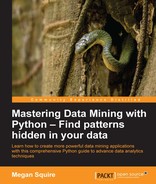After finishing this chapter, we now have a functional understanding of how sentiment analysis works, and we have compared many different strategies that the mainstream sentiment analysis tools use to accomplish this goal. We paid special attention to the Vader tool which comes as standard with the Python NLTK, since it is well-tested and straightforward to use. To learn how to use its sentiment intensity scoring system, we calculated the sentiment for a few different real-world datasets, both messy chat data and somewhat more structured e-mail data.
In the next chapter, we will continue to hone our skills in text mining, but instead of looking at the emotion conveyed by an entire sentence, we will focus our attention on locating entities within sentences. This task, called named entity recognition, is slightly related to the entity matching task we looked at in Chapter 3, Entity Matching, in that in both cases we are working with entities such as people or organizations. However, in our next chapter we add a text mining twist: how can we identify the entities in a text without knowing what we are looking for in advance?
